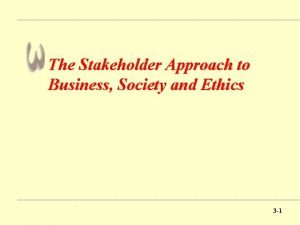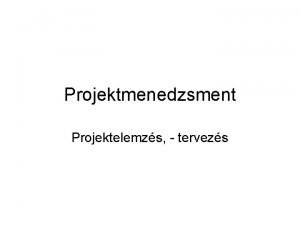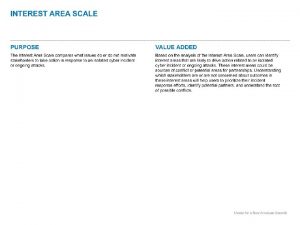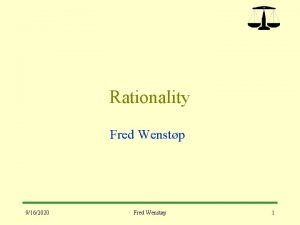STAKEHOLDER APPROACH Summarized from Nickols Fred 2003 A
















- Slides: 16

STAKEHOLDER APPROACH Summarized from Nickols, Fred, 2003 A Stakeholder Approach to Evaluating Training http: //www. nickols. us/stakeholder. pdf

WHY DOESN’T IT WORK? “If evaluation is so important and if the means of carrying it out exist, why do evaluations typically consist of little more than the famous “smiles test”? (p. 1)” Nickols, Fred, 2003 A Stakeholder Approach to Evaluating Training http: //www. nickols. us/stakeholder. pdf

THE PROBLEM “Most of the time, efforts to evaluate training take the form of the required “smiles test, ” a measure of trainee reaction, perhaps some assessment of the learning that has taken place, occasionally an attempt to determine the extent of transfer of training or behavior change on the job and job performance impact, and a rare effort to quantify the bottom-line impact of training and use it to establish the ROI of the training. (p. 3)” Nickols, Fred, 2003 A Stakeholder Approach to Evaluating Training http: //www. nickols. us/stakeholder. pdf

A STAKEHOLDER APPROACH “There is a better approach to evaluating training – a stakeholderbased approach. (p. 1)” Nickols, Fred, 2003 A Stakeholder Approach to Evaluating Training http: //www. nickols. us/stakeholder. pdf

WHAT IS A STAKEHOLDER? “a stakeholder is defined as a person or group with an interest in seeing an endeavor succeed. (p. 3)” Nickols, Fred, 2003 A Stakeholder Approach to Evaluating Training http: //www. nickols. us/stakeholder. pdf

TRAINING STAKEHOLDERS ♠ ♠ ♠ ♠ Trainees The Trainees’ Managers Funding Managers Training Developers Instructors Training Managers Training Vendors Training Community Nickols, Fred, 2003, p. 3 A Stakeholder Approach to Evaluating Training http: //www. nickols. us/stakeholder. pdf

DIFFERENT VIEWS “Although various stakeholder groups readily agree in general about the kinds of results expected from training, they hold very different views about what is important when it comes to evaluating training. (p. 1)” Nickols, Fred, 2003 A Stakeholder Approach to Evaluating Training http: //www. nickols. us/stakeholder. pdf

VALUE TO WHOM? Thus, “in ascertaining the value or worth of anything, including training, one must always ask, “Ascertain its value to whom? ” (p. 2) Nickols, Fred, 2003 A Stakeholder Approach to Evaluating Training http: //www. nickols. us/stakeholder. pdf

WHO CARES? Therefore, “an interesting and useful question to ask about the four (or five) levels of training evaluation is this: “Who is interested in this particular evaluation? ”(p. 3) Nickols, Fred, 2003 A Stakeholder Approach to Evaluating Training http: //www. nickols. us/stakeholder. pdf

CONTRIBUTIONS & INDUCEMENTS ♠ Stakeholders expect ♠ something out of an endeavor (inducements) Stakeholder contribute something to the endeavor (contributions) Nickols, Fred, 2003 A Stakeholder Approach to Evaluating Training http: //www. nickols. us/stakeholder. pdf

CONTRIBUTIONS & INDUCEMENTS ♠ “To meaningfully evaluate training one must assess the nature of the contributions-inducements relationship between each of the stakeholder groups and the training. What are they putting in? What are they getting out? (…) Do they view the transaction as balanced or unbalanced (i. e. , are they putting in more than they’re getting out? ” (p. 4) Nickols, Fred, 200 A Stakeholder Approach to Evaluating Training http: //www. nickols. us/stakeholder. pdf

CONTRIBUTIONS & INDUCEMENTS ♠ See table on page 5. Nickols, Fred, 200 A Stakeholder Approach to Evaluating Training http: //www. nickols. us/stakeholder. pdf

THE STAKEHOLDER APPROACH ♠ Identify the key stakeholder groups ♠ Identify the contributions and inducements ♠ ♠ ♠ for each group Prioritize these contributions and inducements Ruthlessly reduce them to a short list for each stakeholder Devise simple ways of measuring the satisfaction of the various stakeholders with their inducements Nickols, Fred, 2003 A Stakeholder Approach to Evaluating Training http: //www. nickols. us/stakeholder. pdf

THE STAKEHOLDER APPROACH ♠ Devise simple ways of measuring the value of ♠ ♠ the contributions made by the various stakeholders Incorporate them into a Stakeholder Contributions-Inducements Scorecard Check frequently; communicate often; use to drive productive conversations Incorporate into meetings, the training itself and training post-mortems Modify, modify Nickols, Fred, 2003 A Stakeholder Approach to Evaluating Training http: //www. nickols. us/stakeholder. pdf

BENEFITS A stakeholder approach leads to mutual accountability and shared responsibility. Trainers are not and can- not be solely responsible for the success of training. The trainees have something to do with that, too (…) The “smiles test” provides some useful information but it also allows trainees to criticize the training without any accompanying assessment of their behavior and performance as trainees. Nickols, Fred, 2003 A Stakeholder Approach to Evaluating Training http: //www. nickols. us/stakeholder. pdf

BENEFITS “Under a stakeholder approach, the various stakeholders are accountable to one another and they share the responsibility for success” (p. 6). Nickols, Fred, 2003 A Stakeholder Approach to Evaluating Training http: //www. nickols. us/stakeholder. pdf
 Fred nickols
Fred nickols Article 15 counseling example
Article 15 counseling example Stakeholder approach
Stakeholder approach Cognitive approach vs behavioral approach
Cognitive approach vs behavioral approach Cognitive approach vs behavioral approach
Cognitive approach vs behavioral approach What is a research
What is a research Waterfall vs shower approach
Waterfall vs shower approach Traditional approach in system analysis and design
Traditional approach in system analysis and design Approach approach conflict
Approach approach conflict Deep learning approach and surface learning approach
Deep learning approach and surface learning approach Virtual circuit approach
Virtual circuit approach Business and society ethics and stakeholder management
Business and society ethics and stakeholder management Multifiduciary approach
Multifiduciary approach Stakeholder gcse business
Stakeholder gcse business Stakeholder map internal external
Stakeholder map internal external Stakeholder internal and external
Stakeholder internal and external Stakeholder elemzés minta
Stakeholder elemzés minta






























